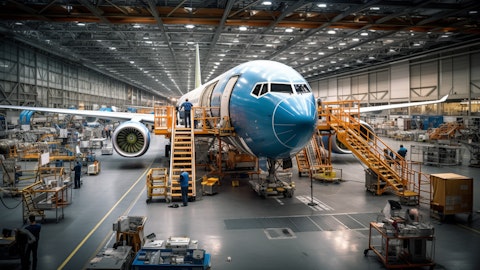David Vernon: Yes. Okay. And then I guess as you think about the yield management, it’s a problem sort of through the summer months, you seem to have a lot more premium capacity into the mix. Does that change the way you guys go about sort of the day-to-day in managing pricing? Are there other opportunities in there that you see to continue to kind of work the segmented cabin differently than you may have done in the past? I’m just trying to get a sense for — as this new sort of model is being marketed at a higher level of volume and a greater distribution of the number of seats you have on each aircraft, is that changing sort of the upper frontier on what you might be able to get out of yield management?
Glen Hauenstein: Well, I think what we said is that, what really pushed us to do this journey several years back was the fact that on the premium products and experiences side, we controlled more of our destiny than we did on the commodity side. And so absolutely, that’s been our journey, is to continue to play the game against ourselves as opposed to playing against the lowest common denominator. And I think we’ll have a lot again on our Investor Day to talk about what we see the next evolution. But we see a lot of runway — not to tease it out, but we see a lot of runway in taking this even further and using new tools and using things that we’ll be talking about in November that I think will be very exciting for our investor base.
David Vernon: Okay. And then last one for me is that you mentioned something about sort of improvements in retailing. Could you elaborate a little bit around what you’re talking about there?
Glen Hauenstein: Well, I think that that’s the holy grail is, why did we wind up in a commoditized environment was because we couldn’t distribute products and services. We weren’t — the industry was not geared to this. And this has been our long journey. And every day, I think we get better and better and better at it, whether or not we’re working internally to improve our own internal displays where we’re 65% direct-to-consumer right now or whether we’re working with online booking tools to improve their display of products and services and making progress on that front as well. So, this has been a very, very long journey and every day we’re working on improving it.
David Vernon: All right. Thanks very much for the time, guys.
Operator: Thank you. Your next question is coming from Sheila Kahyaoglu from Jefferies. Your line is live.
Sheila Kahyaoglu: Hi, good morning, everyone. Thank you for the time. Maybe just a follow-up on Latin America. The large capacity growth there in partnership with LATAM obviously magnifies the unit revenue decline, but you’ve, of course, talked about making these investments profitably. So maybe can you talk about where you are with — today relative to your expectations in Latin America and how you expect that profitability curve to shape up in the coming quarters and years?
Glen Hauenstein: Yes. I think we still see opportunity. We’ve got — a lot of the opportunities now are in our baseline and we’ll continue to work with LATAM to refine that moving forward. But I don’t think you’ll see this kind of dramatic growth in the out years as we’ll be more focused on turning that into more of a harvest mode as opposed to an investment mode as we continue to work on bridging the two networks together.
Sheila Kahyaoglu: Okay. And then maybe one on cost, just to sum it up, Q1 TRASM performance was really good, Ed, and you talked about completion factors and just operations helping that. So, the Q2 guide assumes a bit more normalized putting you guys at 2% cost growth. So, is it just fair to think about that run rate in the context of the year with a low-single-digit guide? And what are the moving pieces as we think about headcount, maintenance costs, and any other noise you’d highlight throughout the year?
Dan Janki: Yes. I think the 2% is in line with the low-single-digit. I think when you think about the variables inside of that run — it starts with running a great operation. When you run a great operation, that sets the foundation. You get those frictional costs out and it really allows the operators and you’re seeing it in two quarters in a row to have the confidence and really lean in and continue to drive not only better improvement in the operation but also get after those efficiencies. And as you do that, in a lot — we said that we’re carrying headcount higher than historical for what we ran in 2019, about 10%, and we’ll grow into that and that drives the efficiency associated with that. And no change to maintenance. Maintenance is as we expected and — but we’ll continue to manage the supply chain. It’s going to be the one that is — has the largest constraint still associated with it as we execute through the year.
Sheila Kahyaoglu: Great. Thank you.
Julie Stewart: Matthew, we’ll now go to our final analyst question before moving to the media.
Operator: Certainly. Your last question is coming from Stephen Trent from Citi. Your line is live.
Stephen Trent: Good morning, everybody, and thanks very much for squeezing me in. Just a follow-up question to Sheila’s, if I may. When we think about probably the — across the industry fleets getting older, could you give us a high-level sense about how valuable Delta TechOps is going to be for you guys over the next 10 years, for example, and that competitive advantage you have versus your legacy competitors? Thank you.




